Greece › Naxos › Things to Do
By Santorini Dave
See Also
- Where to Stay in Naxos
- Best Beaches in Naxos
- Best Bars & Beach Clubs in Naxos
- Best Hotels in Naxos
- Best Family Hotels in Naxos
The 7 Best Tours in Naxos
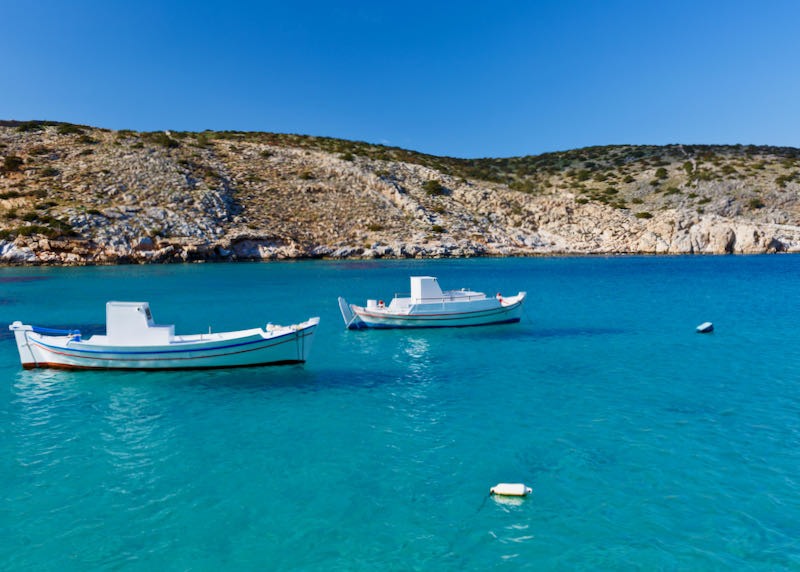
The Full Day Small Cyclades Sailing Cruise takes you to some of the stunning small islands that surround Naxos for a day swimming, snorkeling, eating, drinking, and sunbathing.
- Full Day Small Cyclades Sailing Cruise
Off-the-beaten-track sailing trip to the secluded coves of the less traveled Cycladic islands off the southeast coast of Naxos. A delicious lunch, snacks, beer, and wine are included. Ages 12 and older only. - Half Day Cooking Class at Basilikó Family Tavern
Naxian-Mediterranean cooking class at a charming, family taverna in traditional Kato Potamia village. Pick your own herbs, veggies, and fruits from the garden, watch a local cheesemaker and taste samples, and enjoy a delicious dinner (paired with local wine, of course). - Greek Cooking Class and Dinner at a Village House
Authentic, Naxian cooking class at a traditional family home in the mountain village Melanes, offering a unique glimpse into local life. Prepare a multi-course meal using cheeses, vegetables, herbs, and meats from the village’s gardens and local herders. - All the Marble
Full-day, hands-on, and distinctly Naxian, this tour explores the culture, history, and art of the island’s prized marble. Beginning with a visit to one of Naxos’ active quarries, the tour then heads to the mountain village Apeiranthos with streets, stairways, and buildings made from marble. The tour ends with a 2-hour marble sculpting workshop, where you’ll carve your own marble art. Lunch included. - Full Day Sailing Cruise
Wonderful, all-day yacht adventure filled with swimming, snorkeling, and sightseeing of traditional villages, castles, and sea caves. The itinerary varies depending on sailing conditions, but usually includes a visit to Rina Cave, Kalados Bay, Schinoussa Island, Paros, or Antiparos. - All Inclusive Cruise on a Luxurious Catamaran
Superb, all-day cruise exploring, swimming, and snorkeling at Naxos’ best secluded beaches and sea caves. A traditional lunch with beer, wine, and raki is included, along with all-day snacks and refreshments. - Delos and Mykonos Full Day Boat Trip
A busy trip combining a visit to the archaeological treasure of Delos Island, mythological birthplace of Apollo and Athena, with an afternoon exploring the sights, shops, and port town of cosmopolitan Mykonos. Opt to hire a private guide or join one of the small group tours available when you land on Delos. Note that the boat is small and the water is often choppy, so bring anti-nausea pills if needed.
The 21 Best Things to Do in Naxos
1. Plaka Beach
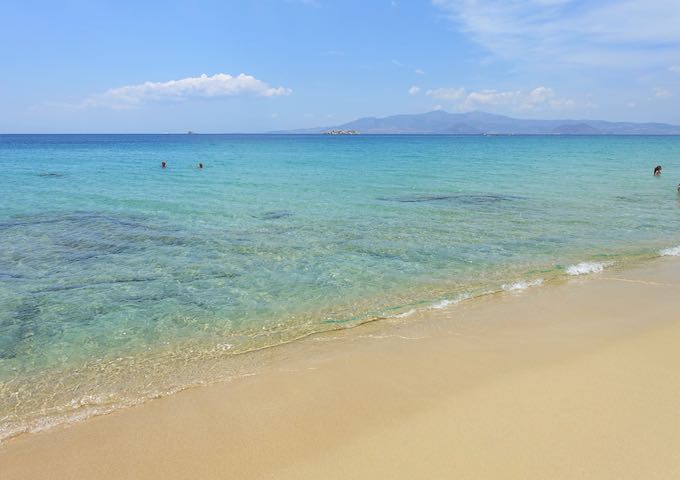
Naxos is renowned for its long, sandy beaches with shallow, turquoise water, and Plaka is the best of them all. Running 4 km down the west coast, Plaka Beach is the longest, uninterrupted beach on the island and features soft, golden sand and excellent swimming. The north end of the beach (also called Maragas) has the bulk of Plaka’s tavernas, beach clubs, and hotels, while the south end has fewer amenities and a more tranquil atmosphere. The beach is easy to reach by bus for those staying in Naxos Town.
2. Apollo Temple
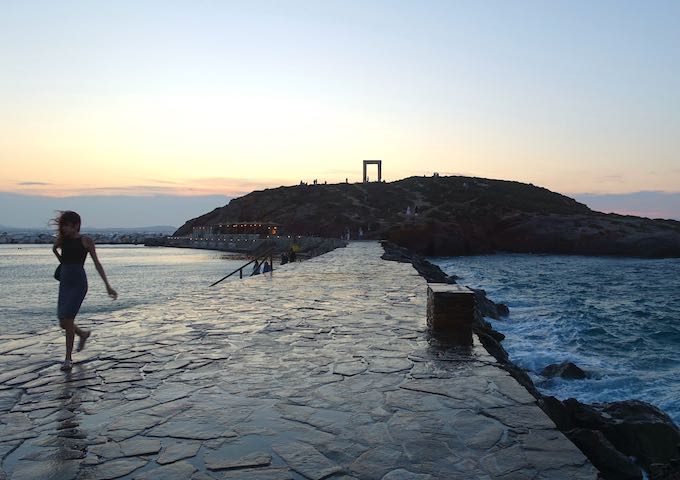
Naxos’ most recognizable landmark is the Portara, the oversized marble gate of the never-completed Apollo Temple. This Ionian-style temple dates back to the 6th century B.C, built by the tyrant Lygdamis and abandoned after his defeat by the Spartan army. The temple ruins sit near Naxos’ ferry port on the islet Palatia, the mythological place of Princess Ariadne’s abduction by Dionysus. The islet is connected to Naxos Town by a raised footpath and is the best place for watching the sunset on the island. Open 24-hours a day.
3. Panagia Drosiani Church
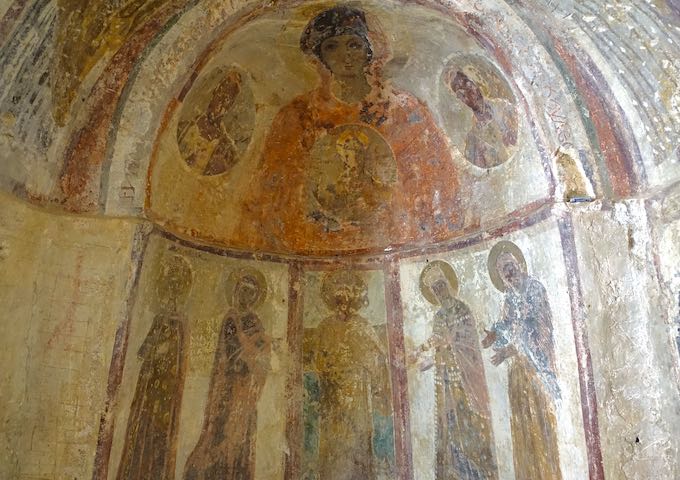
Dating at least to the 6th century A.D., the Church of Panagia Drosiani (Dewy Virgin) is the oldest and most important church in Naxos and among the oldest in the Balkans. This small, stone church features a cross-shaped layout with a large dome featuring two depictions of Jesus Christ Pantokrator, while the altars and walls are filled with original frescoes of the Virgin Mary, St. George, and more. The frescoes on the walls are the originals and were buried under 2 layers of newer frescoes that have since been removed to museums. A few cave-style chapels branch off the main room, where monks and nuns secretly taught local children Greek language and Orthodox religion during the Ottoman rule. Located on the hiking trail between Moni and Chalki, the church grounds offer sweeping views over the Tragea Valley.
4. Agios Georgios Beach
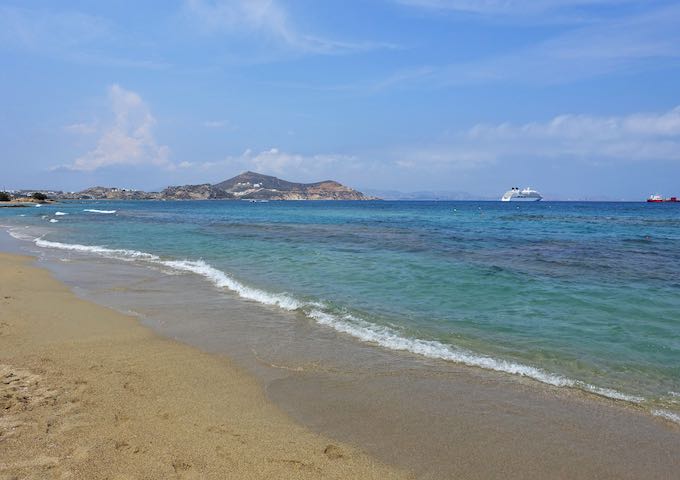
Family-friendly Agios Georgios Beach (aka St. George Beach) is a lively beach with gold and white sand and shallow, calm water perfect for children. This busy beach is lined with casual restaurants, beach clubs, and shops, plus a water sports center at the south end. The closest beach to Naxos Town, Agios Georgios is convenient to most of the island’s best hotels on foot or a short bus ride away.
5. Naxos Port
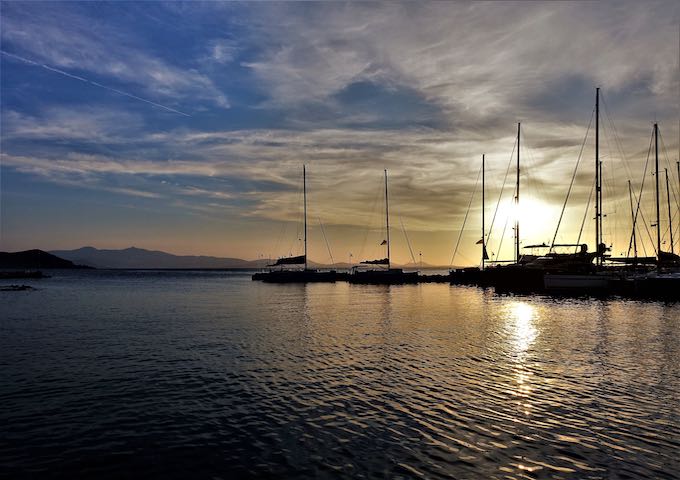
The Naxos ferry port sits at the northwest side of Naxos Town near the footpath to Apollo Temple with a picturesque marina immediately south. The bustling port brims with casual tavernas, cocktail bars, souvenir shops, and boutiques. In the mornings, you’ll find local fisherman hauling fresh catch and strings of octopus drying in the sun. In the evenings, this is one of the best spots to catch the sunset, especially from one of the balcony restaurants or rooftop bars. Late at night, this is the nightlife hub of the island with a handful of bars and dance clubs open until the wee hours. The whole port strip is around 700 m long and takes less than 10 minutes to walk (and less than 15 if you walk all the way to the temple). Ideal for any time of the day.
6. Chalki
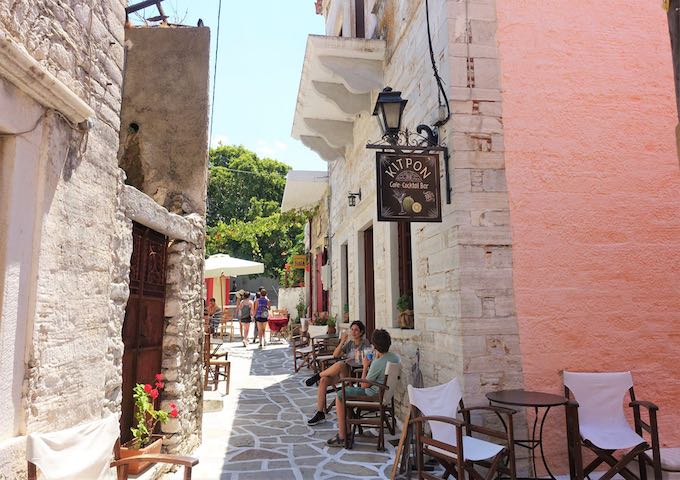
Also written Chalkio, Halki, or Xalki, this is the most charming of Naxos’ mountain villages. If you only have time to explore one village, make it Chalki. This is the former capital of the island and is filled with rich history, neoclassical architecture, Byzantine churches (including the 9th century Panagia Protothroni), Venetian towers (the most prominent being the 17th-century Gratsia Pyrgos), and a colorful maze of lanes. The local spirit kitron, a citrus liqueur, is made here in the Vallindra distillery, operating since 1896; tours are free and include samples. The pedestrian lanes of Chalki are filled with workshops and handicraft boutiques, serving artisanal cheeses, traditional textiles, local produce and products (especially olive oil – the surrounding Tragea Valley produces most of the Cyclades’ olives). This village offers a handful of delicious restaurants, cafes, bakeries, and bars serving signature kitron cocktails.
7. Alyko: Cedar Forest, Beaches, Street Art
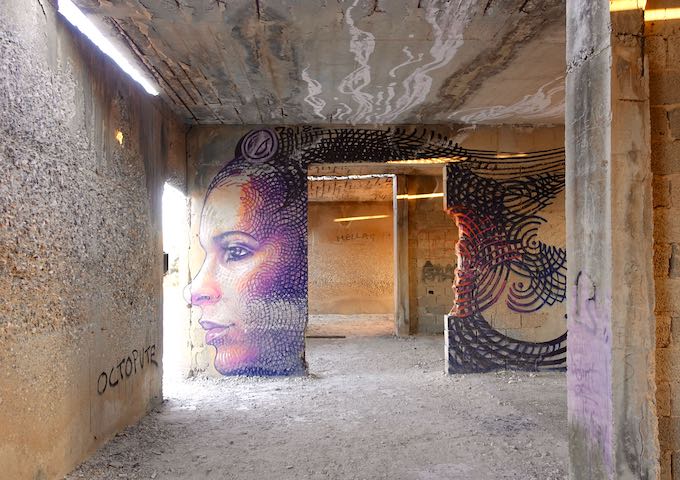
The largest and densest of Greece’s 8 cedar forests, gorgeous Alyko spans 800 square meters filled with several species of cedar, heather, wildflowers, and more. Four small, sandy beaches circle around its rocky coastline: a nude beach Alyko Naturist at the northern end, Hawaii Beach (the longest, sandiest beach here) immediately south, Mikrolímano facing west and protected from the wind, and Alyko Forest Beach at the edge of the cedars. Standing out in this otherwise natural area are the ruins of a never-finished hotel, now filled with vibrant graffiti murals – free to enter anytime and worth a visit on their own.
8. Day Trip to Paros
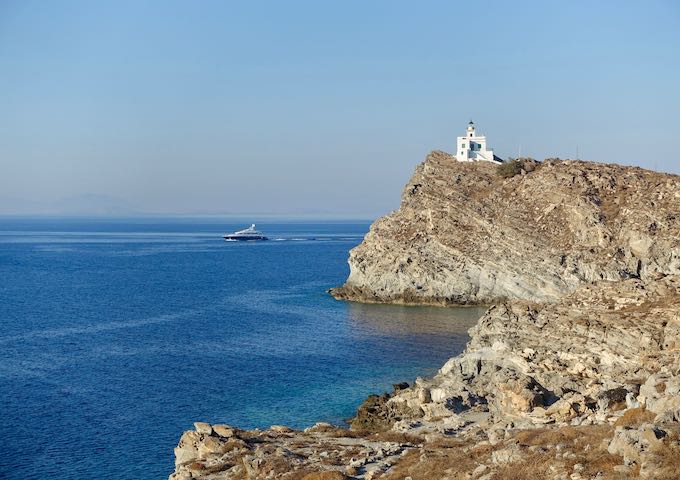
Though Naxos and Paros are geographically close together, they each have a distinct feel, making a day trip to Paros highly worth your while. Paros has two main villages: Parikia- the capital with a bustling port, the Byzantine Panagia Ekatontapiliani (Church of 100 Doors), and the Frankish castle ruins- and Naoussa- a cosmopolitan village with semi-sunken castle ruins at the old port, fine dining, stylish boutiques, and a winery. A small fishing village Piso Livadi sits at the south end of the island with sandy beaches and amazing, fresh seafood restaurants. Like Naxos, Paros is surrounded by excellent beaches, but the beaches on Paros are unusual, from the strange rocks of Kolymbithres to the healing mud beach Kalogeros. Paros Park covers 800 acres in the north with hiking trails, a beach, lighthouse, and an open-air cinema. From Paros, you can take a smaller boat to the islands Antiparos or Despotiko for more secluded beaches. Standard ferries run between Naxos Town and Parikia ports about 8 times a day, taking about 40 minutes. Or take this Independent Day Trip to Paros, which takes only 30 minutes and docks at Naoussa.
9. Hike from Moni to Chalki
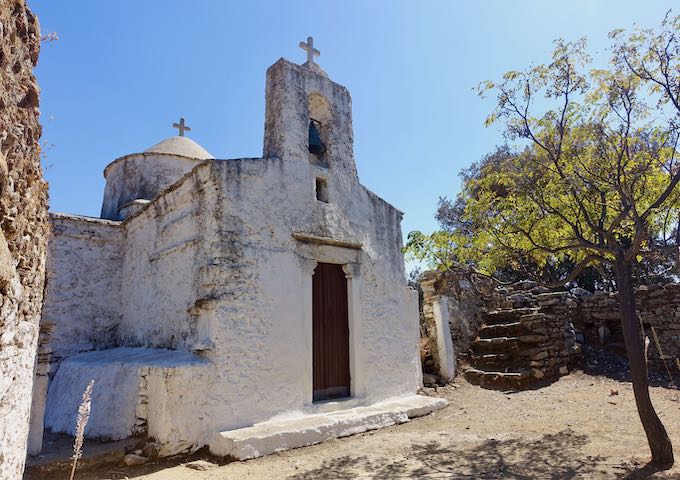
Many of the inland villages of Naxos are connected by centuries-worn pathways of varying degrees of difficulty. One of the most pleasant and treks is on Hiking Trail #4, a loop path connecting the villages of Moni and Chalki, winding through olive groves and vineyards, and passing by several of Naxos 200 Byzantine churches along the way (like the one pictured above). Begin at Moni, explore Panagia Drosiani Church (the oldest in Naxos, dating to the 6th century A.D.), pass through Kaloxylos to see Agia Triada Church (Holy Trinity) and its marble iconostasis (wall of icons), then Akadimi with its old Venetian tower, and finally end in Chalki. The former capital, Chalki features colorful pedestrian streets filled with tavernas, craft workshops, the kitron distillery, and the best-known Venetian tower, Barozzi. From here, take a detour to Agios Georgios Diasoritis, an 11th century church with beautiful frescos (hours are irregular, your hotel can check ahead to see if it’s open). Heading back, pass by the humble churches of Agia Marina (circa 11th century) and Panagia Rahidiotisa (circa 17th century) before arriving in Moni. The whole loop is well-marked with signs, combines dirt paths, stony trails, and cobblestone-paved streets, and takes a little over 2 hours. Plan on taking extra time to explore the villages and churches.
10. Hike Mount Zas

This is Naxos’ best-known hike, climbing to the 1000m summit of the tallest mountain in the Cyclades, Mount Zas (Zeus). A cave on the northwest face of the mountain, Zas Cave, is the childhood home of Zeus, hidden away from his father Cronos, who had previously eaten his 5 siblings. There are 2 popular routes to reach the peak. The easiest, most popular, best maintained, and best-marked route begins near Agia Marina church in Filoti (not the aforementioned church near Chalki) and climbs steadily up for 8 km to the summit but does not pass by the cave. To reach Zas Cave, pictured above, take the more challenging route beginning at Aria Spring with a wide, easy-to-follow trail that eventually disappears and turns into a scrabble to the cave and then to the peak. Though 2 km shorter, this route is much more arduous. Go early to avoid the heat, bring plenty of water (you can fill up at Aria Spring), and bring a flashlight to check out the cave.
11. Castle of Naxos
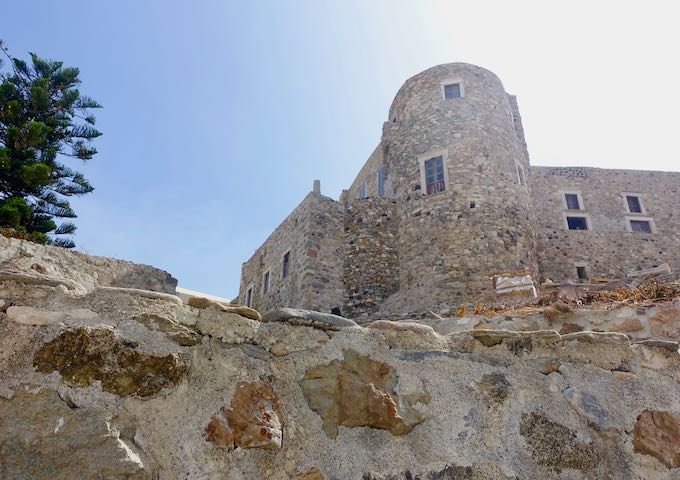
Dating back to 1207 and located in Naxos Town, the Castle of Naxos is a medieval fortification built by Venetian conquerors, who made Naxos the capital of the newly established Duchy of the Aegean. The castle was built over the ruins of an ancient acropolis, already badly damaged by pirates. The best-preserved portion is the Tower of Glezos (aka Tower of Krispi), the only surviving tower of the original 12 built, located at the northwestern Trani gate. The steps leading up to the castle are narrow with high stone walls on both sides. Surrounding the castle are the excellent Archaeological Museum of Naxos and numerous Catholic churches, monasteries, schools, and mansions used over the centuries by descendants of the Venetians.
12. Temple of Demeter
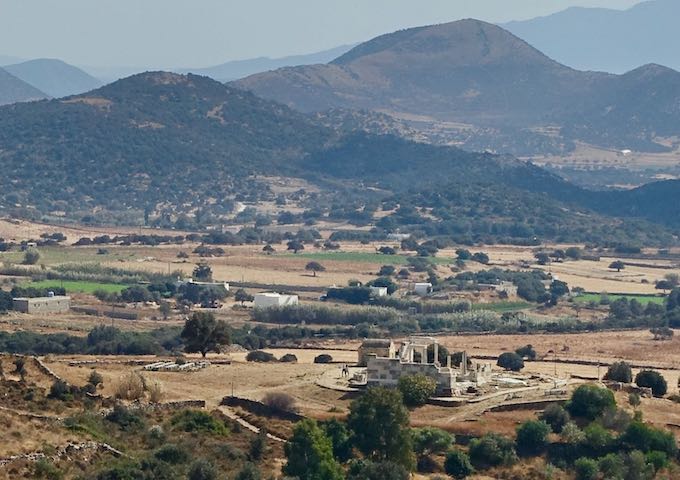
The Temple of Demeter dates back to about 530 B.C., though the site itself was used for religious ceremonies as far back as the Mycenean era a thousand years before. Dedicated to Demeter, goddess of agriculture, the temple’s site was built in the greenest, most fruitful part of the island and built from high-quality, white Naxian marble in an early example of the Ionic style. The temple was demolished around the 6th century A.D. by Christian rulers who used its ruins to erect a church, which was subsequently destroyed and ransacked for its marble. What remained of the original temple was beautifully restored by archaeologists around 2001; a small museum housing artifacts from the temple grounds was also built at the site. Located near Mikri Vigla Beach, the temple is open to visitors most days from 8:30 a.m. to 3:00 p.m., but do check ahead to be certain.
13. Naxian Cuisine

Naxos is the agricultural heart of the Cyclades, the only island in the archipelago that isn’t a barren desert. The food grown here supplies almost all of the fine dining restaurants of nearby Santorini, Mykonos, and Paros. Local culinary tradition is strong here with ingredients as varied as the landscape: fresh-caught fish and octopus from the coastal villages; beef, cheeses, and vegetables from the interior; and goat, sheep, olives, and kitron liqueur made from citron leaves from the mountains. Standout dishes to try in Naxos include rooster braised in tomatoes and wine, lemon-braised rabbit, grilled octopus, famous Naxian potatoes cooked in any style, and melachrino (walnut cake doused in kitron). Many of the island’s best restaurants are in Naxos Town (including Doukato, pictured above), though there are excellent restaurants spread throughout the island. Even better, take one of the cooking classes listed in the tours section above.
14. Windsurfing and Kitesurfing
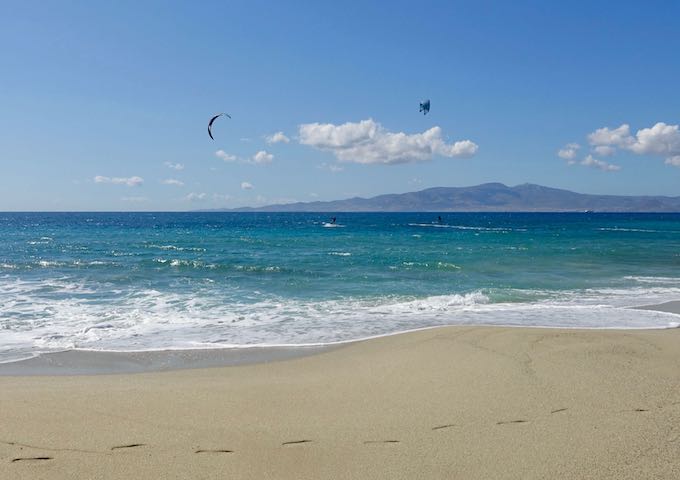
Like all Cycladic islands, Naxos is subject to the meltemi, strong northern wind that blows from May through October, peaking in July and August. However, unlike other islands, a compression effect with neighboring Paros boosts the wind strength, making Naxos the best spot in Greece for windsurfing and kitesurfing. The best beaches for kitesurfing and windsurfing are north-facing Mikri Vigla, Agios Georgios, Glyfada (above), and Laguna Beaches, all with water sports centers with rental equipment, many offering lessons. On extra windy days, Agios Prokopios and Plaka Beaches also offer great conditions.
15. Mountain Villages

Naxos is best-known for its sandy beaches, but what makes the island unique among others in the Cyclades is its fertile yet mountainous interior dotted with villages steeped in tradition. In the mountain villages, many locals create handicrafts in artisanal workshops, prepare cheeses and marmalades from family recipes, harvest olives and grapes by hand, or herd flocks of sheep and goats through rugged terrain. Chalki is the most charming, but there are many villages with rich histories and cultures to explore. Sangri is home to the Temple of Demeter; Filoti (above) houses several Byzantine churches and the trailhead to Zas Mountain; Melanes is home to the two ancient Kouros statues; Moni boasts the island’s oldest church, Panagia Drosiani; Apeiranthos features marble streets and stairways, Cretan roots, and wonderful museums; and Vivlos is known for its ancient windmills and Panagia Tripodiotissa church with its carved, wooden iconostasis.
16. Sunsets
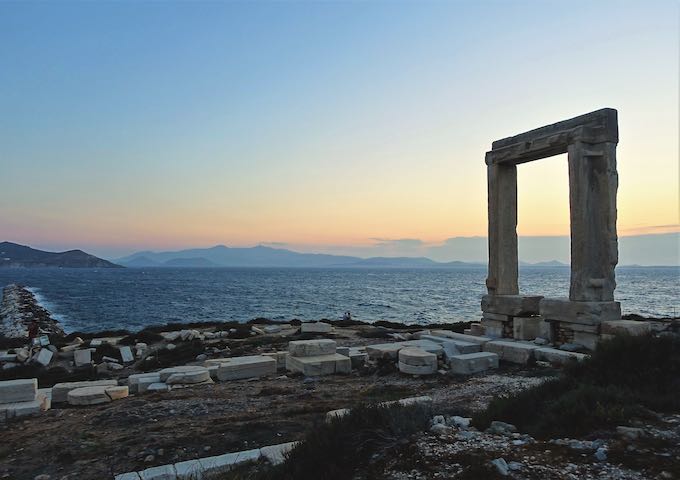
Cap off a perfect day in Naxos with a stunning sunset view. The best spot to watch the sun sink into the sea is from Apollo Temple. Cross the footpath and climb to the top of the hill at the Portara for an unobstructed view. Another excellent spot is on the hill above Grotta Beach, a quiet little perch with a full view of the sunset next to the temple ruins. For sunset dining, reserve a table at one of the balcony or rooftop restaurants at the port (Boulamatsis is the best) with views over the marina and Portara. For sweeping panoramic views, head inland to the mountains. Rotonda restaurant on the road to Apeiranthos overlooks hills and valleys, chapels, olive groves, and the sun setting into the Aegean Sea.
17. Marble Quarries
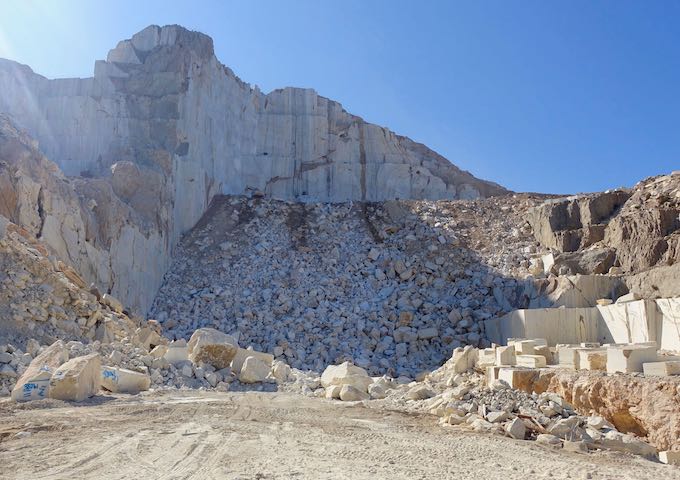
The marble of Naxos has been prized since as far back as the Neolithic Era. Many of Greece’s most famous sculptures were carved out of marble quarried from the central mountains between the villages Kinidaros and Melanes, including the Lions of Delos and the Sphinx of Delphi, and of course Naxos’ own monuments, Apollo Temple, the Temple of Demeter, and the Kouroi. There are a few active quarries in Naxos, the largest just north of Kinidaros, recovering high-quality marble commercially known as Naxos Crystalline, a sparkling white marble flecked with quartz. The quarries are large, visible from the road when driving past, but it’s best to appreciate its qualities up close on a guided marble quarry and workshop tour.
18. Cine Naxos
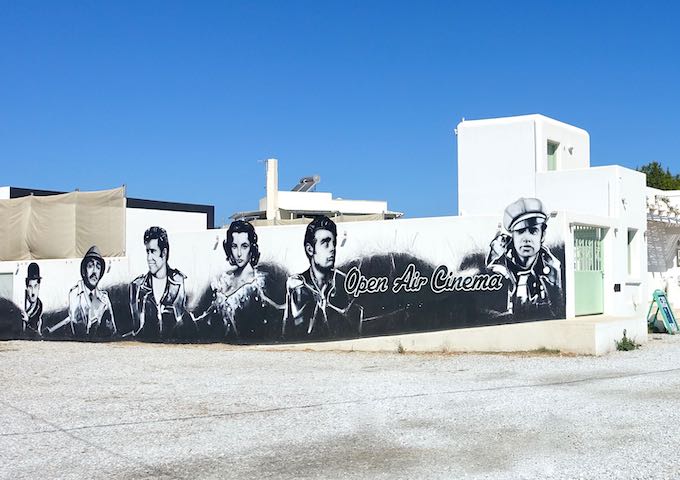
Cine Naxos, a wonderful, open-air movie theater, shows current movies nightly under the stars. Films are typically in English with Greek subtitles with new movies premiering on Thursday nights. There are usually 2 screenings per night, one at 9:00 p.m. and another at 11:15 p.m. A small kiosk serves wine, sodas, and snacks and tickets cost about €7.50. Cine Naxos is due east of Agios Georgios Beach, less than a 10-minute walk away, about a 10-minute walk from Chora, or a 15-minute walk from Naxos Port.
19. Old Market of Naxos Town
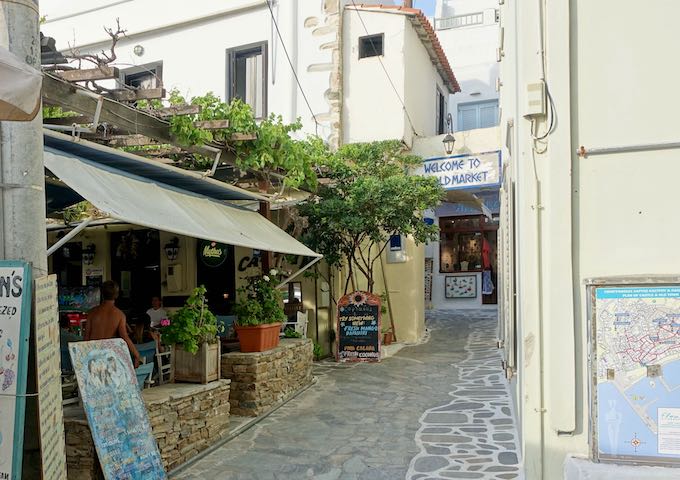
The Old Market is a jumble of narrow, cobblestone paths and stairways passing through archways and little tunnels all around the Naxos Castle. The Old Market is in the Bourgos neighborhood, where the Greeks lived under Venetian rule. A pleasure to get lost in, this area is filled with boutiques, local food shops, galleries, tavernas, and bars – many with sunset views. You’ll find excellent souvenirs in these stores (though the most authentic shopping is in the mountain villages) and a buzzy atmosphere. Like the rest of Chora, the Old Market area is busy any time of day, but unlike the areas farther south, some of the bars and clubs in the Old Market stay open until nearly dawn, making this the nightlife hub of the island.
20. Naxos Nightlife
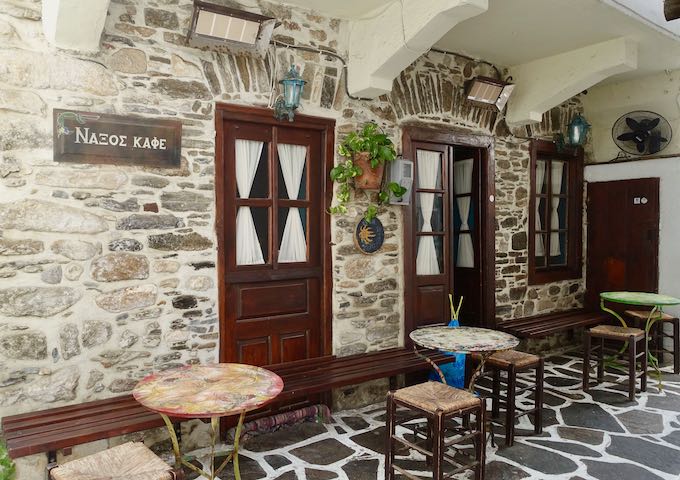
Naxos is not known for its nightlife, but if you know where to look, you’ll find incredible bars and clubs with traditional or contemporary styles. Nightlife in Naxos is not as crazy (or expensive) as it is in Mykonos, and not as cosmopolitan as Santorini or Paros. Bars and clubs here tend to be more casual, more friendly, and more authentically Greek – whether you’re looking for sunset cocktails, all night dancing, or local wine tastings. Most of Naxos best bars are located in Chora, especially in the Old Market or overlooking the port, though there are a handful at the beaches and in the mountain villages (especially in Chalki near the kitron distillery). Among the best are Like Home (sunset views and great cocktails), Naxos Café (authenticity, local spirits, live music/DJ sets after 10:00 p.m.), and Oniro Wine Bar (local wine and Naxian fare with sunset views).
21. Beach Clubs
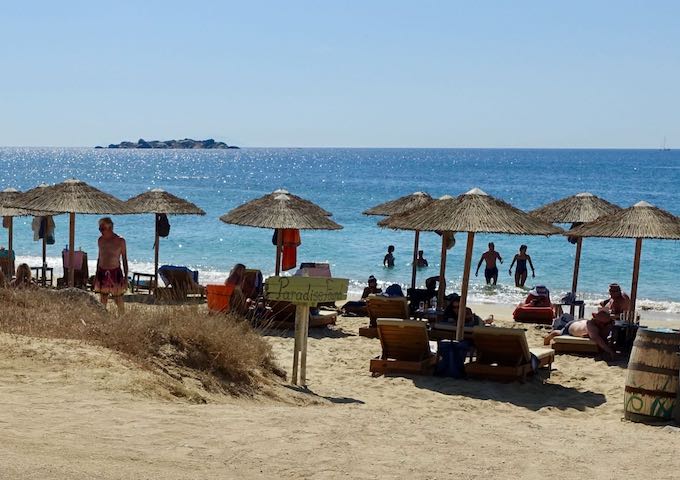
There are surprisingly few beach clubs on Naxos, considering the amazing quality of beaches here. Many beaches in Naxos are left natural, while many more have casual beachfront restaurants with sunbed rentals, but not really a “clubby” vibe. However, there are a few, low-key beach clubs with excellent music, refreshing cocktails, and parties in the afternoons and evenings. Yazoo Summer Bliss on Plaka Beach is the original Naxian beach club and is still the heart of beach life on the island, known for their monthly full moon parties, excellent Cretan menu, and handcrafted cocktails. Santana Beach Club on Agia Anna is one of the top party spots on the island with parties all summer long on Wednesdays, Fridays, Sundays, and select Saturdays. A little farther north, on Agios Prokopios Beach, Macao Beach Project is a newer beach club with a relaxed vibe, great music, occasional parties, and contemporary Mediterranean-Asian fusion cuisine.
About Santorini Dave